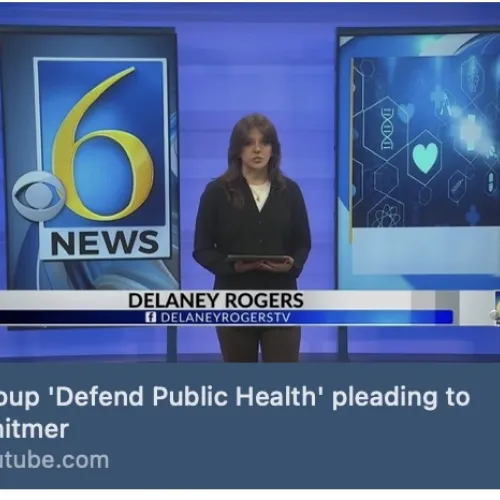Opinion
October 29, 2025
The Killing Smog of Donora, Pennsylvania: A Halloween Reminder from the Past
By Kathleen Shoop, PhD
The Death-Dealing Smog over Donora, Donora Death Fog, and Five Days of Fog are just a few of the titles that the infamous 1948 killing smog has been given over the years. Hyperbolic language? No. The titles fit, because as the fog and smoke began to settle over the small western Pennsylvania town on October 26, 1948, what happened next changed the lives of individuals both in Donora and around the world.
Between October 26th and October 31st, the typical smoke and fog that Donorans lived with thickened, blackened, and ultimately penetrated the bodies of citizens like never before. Before Donora became a steel-town powerhouse, it was farmland, coal mines, and hillsides that soared 400 feet up from the riverbank. Like sentinel eagles, the sandstone and shale slopes watched over the valley. In autumn oaks, maples, hickories, and sycamores turned orange, red and yellow, and evergreens housed native birds wintering over.
But as industrialization developed in America, Donora's location in a horseshoe bend of the Monongahela River made it the perfect location to build a steel mill. Three miles of steel and zinc works gave birth to a town. Homes were built on every available inch of land. The Donora Historical Society reports that in 1900, "What was once a village of only four houses with twelve persons residing therein, the new town would swell in three years to 1,000 buildings and over 6,000 people."
From sparsely populated farmland to the steel mills that built America, Donora lost one identity but birthed another. A magnet for skilled immigrants willing to toil with their hands, and for well-off men looking to grow their bank accounts, several versions of the American Dream were defined and achieved under the gaze of those hills. By 1948, Donora boasted 14,000 residents, and the town was about to be redefined again.
Recipe for Infamy
On October 26th, 1948, fog and smog collected in the river flats as it always did in Donora. Three miles of riverside industry belched their waste. No longer new, the buildings had become blackened. Like always, residents started their days by wiping down trim inside their homes, cleaning storefront windows, and changing into fresh shirts after arriving at work; pollution from the mills required regular removal of soot and black, greasy mill debris. The scent of sulfur dioxide cloaked the town--just another day of prosperity.
The magnificent topography of those stalking hillsides played a starring role in turning Donora's typical foggy, smoky days into a deadly disaster, and the town structure also played scapegoat. The rise of Donora's slopes would encourage air masses to go still and stay enclosed in the valley. Sometimes atmospheric conditions dropped a cold layer of air, acting as a lid, right over all of it, trapping the warmer air below and all of the pollution along with it. This was the case during Halloween week in 1948. The cold air lid stayed put, and the acrid chemicals collected below it, down where people were going about daily life. This weather event is called a temperature inversion, and they happen around the world all the time. But by Thursday, October 28th, citizens in Donora had begun struggling to walk through town. And the coughing had begun.
By October 30th, Dr. Koehler, one of eight physicians in Donora, looked out his bathroom window. He was mesmerized by the sight of smoke rising out of the stack of a freight train. But instead of the smoke rising and dissipating in the air, it hit that cold air lid.
"It just spilled out over the lip of the stack like a black liquid, like ink or oil, and rolled down to the ground and lay there”.
Koehler arrived at his office which he shared with other doctors and their nurse, Helen Stack. Needing respite, Koehler attempted to calm himself with a cigar which tasted like the polluted air. Stack scoured the office to get rid of a wet substance that came with the fog, only to find that her cigarette also tasted like what she'd just cleaned. Both boss and employee were nauseated and shocked at what they were experiencing.
The phone calls started, with people crying out for help. Stack would hang up the phone and it would ring again. Many of their patients with chronic asthma arrived, and Koehler provided adrenaline shots or anti-spasmodics. The phrase "the fog got him, or got me," began to be spoken around town, giving the sense of the smog being a sentient lifeform.
“These men stormed the beaches of Normandy— what’s a little smoke to them?”
-Harry Loftus, Interview with Kathleen Shoop 2008
Interestingly enough, not everyone was aware that the smog was having a dire impact on fellow citizens. It was common for heavy fog to settle in town, and the mill pollution was ever-present, frequently affecting people who were elderly or who had chronic conditions. How could this be possible? Part of the answer was simple. Without constant media access as we have now, the number of people calling for the doctor because they felt they were dying—struck down by bloody coughing, choking, nausea, headaches, and more--was not conveyed to others. In addition to lack of information, a layer of denial lived in the mindset of the townspeople.
So it was that as Koehler's office filled up and Stack's list of house-calls grew, many Donorans were still unaware of the seriousness of the problem. Eventually the doctor announced he had to leave in order to address the most serious cases, which continued to multiply.
Yet as he was ushering the sickened people out of his office, sounds of revelry filled his ears. Marching band music, laughter, crowd noise: the height of normalcy stunned him. The Halloween parade was trooping through town. People lined the sidewalks, handkerchiefs over their mouths, to watch the kids pass by in their costumes. A parade goer, Mrs. Chambon, discussed her thoughts when it ended. "I was glad to be back in the house. I guess everybody was. The minute it was over, everybody scattered. They just vanished. In two minutes there wasn't a soul left on the street. It was as quiet as midnight."
The parade crowds may have dissolved into thin air, but the town’s firefighters were about to begin making rounds to homes, giving people "shots of oxygen." They wouldn't stop working until Sunday night, their ambulances often being led with a man on foot with a flashlight to ensure they stayed on the road. There was no way for eight doctors to get to everyone needing care. Even with all the ambient light in Donora, with 24-hour mill activity including blast furnaces, zinc retorts, and more, it was so dark that, “That fog was black as a derby hat," fire-chief John Volk said. "You couldn't see your hand in front of your face," firefighter Russell Davis reported.
The first victim of the fog was retired steelworker, Ivan Ceh. He died at 1:30 AM on Saturday. By 10:00 AM, eleven people were dead. The undertaker in town couldn't move fast enough. As reported by Roueche in The New Yorker in 1950, the town’s Burgess had this to say when he was notified of the deaths and illness:
"The fog didn't even enter my mind…I hadn't paid it any special significance… Jesus, in a town like this you've got to expect fog. It's natural. At least that's what I thought then."
Still, up on the hills that watched over Donora, Saturday's high school football game was played. There was less smoke up there, but heavy smog still colored the field. A mythology grew around that game, with some claiming the players couldn't see to throw passes and that one player was called out of the game because his father was dying down below. Mythology or not, news was spreading about sickness and deaths, but again, what Donorans were experiencing wasn't so far out of the norm that they grasped the weight of it all. On Saturday, the Burgess alerted the state board of health, finally organizing a meeting with the mill officials on October 31st.
In the odd blend of chaos and normalcy, the mill officials seemed to have been quiet until the meeting. They denied any thought that the steel works, wire mill, or zinc works had anything to do with the death and illness. Yet they had begun the process of "banking the fires" at six that morning, suggesting they were, in fact, aware. Later that day, the rains came, and by evening the cold air lid was blown off of the valley, and the air finally moved. As Burgess Chambon recalled to Roueche in 1950, "The air was different. It didn't get you anymore. You could breathe."
In the end, there were twenty people dead and 6000 sickened by the Halloween week smog.
This event was the impetus for the first coordinated, large-scale epidemiological investigation to discern the cause of an industrial-related health crisis. The villainous scapegoat was named as the temperature inversion combined with the geographical features of the town. Donora's topography had invited businessmen, laborers, and happy families into its valley. Those steep, watchful hillsides that corralled the colder air and allowed it to trap the warmer layer coming off the Monongahela River waters below shouldered the blame for the Killing Smog. But the reality was that none of it would have happened without unregulated industrial pollution.
The 1948 Donora Smog led to the 1955 Air Pollution Control Act, and eventually to the 1970 Clean Air Act. Later, the Donora Historical Society and Smog Museum was founded, and the slogan "Clean Air Started Here," was born.
You might be wondering how this could happen; how Donorans wouldn't have protested heavily for change or just moved to escape the regular, smoggy conditions. But Donora boasted championship sports teams, athletes like Stan Musial, and happy families who'd discovered the promise of prosperity in exchange for hard work. Financial stability went far toward helping people ignore the consequences of the industry that provided for their families. The way Donorans saw the world was born of more than flashy success stories and greed.
“Many people from Donora were immigrants or their parents were. Things were bad where they came from and they had nothing. Many of them had lived in lands of kings. Life in Donora was good—no one could tell them what to do because they weren’t born into a certain family. And they weren’t going to mess that up because of a little bit of fog.”
-Charles Stacey, PhD, in a 2008 interview with Kathleen Shoop
We have now revisited the Death Fog as outsiders living nearly one hundred years after Donora's heyday, so it may be nearly impossible to fathom living in the shadow of these hulking, spewing mills. But it can happen again--the denial that what brings us prosperity might not be good for us or the earth.
Take a look around. Is it happening now? Are we just looking the other way all over again?


